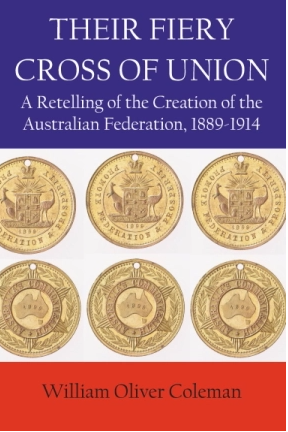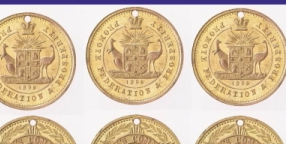Review of William Oliver Coleman, Their Fiery Cross of Union, A Retelling of the Creation of the Australian Federation, 1889-1914, Connor Court Publishing, 2021, Australian Catholic Historical Society Journal, Vol. 42, 2021, pp. 148-151.

Here is a radical reassessment of 1901, the formation of Australia viewed as a less than glorious moment in Australian history. Economist, economic historian, and Australian Federation critic William Oliver Coleman argues and writes well, though leaving room for doubt about his critique and conclusions. The title, the “Fiery Cross of Union”, is inspired by words from notes found in the archives of Hume Cook, also described by Coleman as “fluent and facile,” a close ally of Deakin, and a protectionist “true believer.”
Recent Australian historiography takes issue with celebratory accounts of the development of Australian society, including older nationalist accounts. Often this is done by applying Marxist, feminist, Indigenous and other perspectives. But this book’s approach is different. It combines the rigour of cost-benefit analysis written in sparkling prose with close attention to original documents and with the benefit of wide reading.
Some passages excel. For example, Coleman says: “A now familiar estimate of the Australian character had been formulated by the 189os: laconic, nonchalant, slapdash; lackadaisical in enterprise, perfunctory in religion, cursory in civic duty. Passionate only about sport.” At times, however, the assessments read like erudite and more serious versions of Valerie Desmond’s comic The Awful Australian (1911). Almost certainly written by John Norton under that pen-name, the book begins: “Should a howl of indignation be provoked, then will the condition of affairs be proved worse than my pen has power to depict, and nothing will be left but to declare Australia past redemption. This is the case for the prosecution.” Similarly, Coleman relishes a provocative phrase, pithy statement, and humour in making his point.
Coleman’s theme is that Federation made a state more than a nation: “…rather than constituting an advance, it might be apprehended, more neutrally, as a constitutional upheaval; the downfall, and supersession, of an extant political order.” He summarises: “those origins were more frequently mundane than elevated; its leadership was, at its very pinnacle, mediocre; its democracy was mechanical, and, at the worst moments, fraudulent” – these are hefty and unsettling charges.
He argues it was a costly ‘bargain’. Instead of ending unholy tariff barriers between comrades in the different Australian colonies, “free trade at home and protection from abroad” became part of the Federation bargain – and thereby fostered protected industries, inefficiencies, and the handicap of a non-entrepreneurial culture. What was good for Victoria was not necessarily great for all. Those who paid the price possessed less significant clout than the victors.
Slogans such as “a nation for a continent,” insipid calls to nationhood, require evaluation and the weighing of intention, consequences, including long-term impacts. To this challenge, Coleman is an able combatant. He offers original perspective.
Coleman deflates myth after myth, such as the claim that Federation was a vigorous, authentic expression of native nationalism. On the contrary, Federation is better understood as an exercise in Empire-ism: “The simultaneous embrace of the Boer War and Federation is easily explained if both crusades are interpreted as a species of pan-Britainism.” This, plus a White Australia, Australians for Australians, industry for and by Australian hands, was the winning formula to claim assent from the public.
Coleman sneers that the “plastic” nationalists’ nationalism was the nationalism of “careerism, proxyism and surrogatism.” Cui bono? is the question to explore for answers.
He points out that generally, in the period leading up to 1901, and until World War I, the Australian nationalist impulse was weak, as was anti-Britishism.
Although there is a school of thinking that links the boom in Australian national literature in the late 1890s to the championing of Australian nationhood, Coleman has some dousing responses. He points out that the flare of “offensively Australian” nationalism lasted about a decade, from 1896, petering out early in the twentieth century.
Coleman returns again and again to the features of the creation. The one thing “they managed to make was not a nation, but a state.” Which begs the question, as Coleman suggests, whether this was better than any that was stifled.
Coleman sees a nation beset with cynical politicians. He describes types of politics and politicians: ‘roads and bridges’ advocates versus the crafty politician apparently espousing the politics of the ideal. The latter can be further delineated into single-issue totemic ideal champions (e.g., for anti-Chinese legislation, characteristic of many politicians in Australia in the late 19th and early 20th centuries) and others focused on ‘divide and rule’ wedge politics; for them, the ‘sinker’ is the stratagem to introduce a second ideal that pre-empts, over-rules or “trumps” the first ideal.
Parkes’ anti-Catholicism is an example of a sinker move. He out-foxed opponents. But in politics, there are few permanent victories. Parkes lost his seat in the NSW parliament after his 1880 Public Instruction Act, which provided compulsory free education and severed connections between the church and the public schools, was passed. Partly, Parkes was driven by electoral uncertainty. He was “often pre-eminent, but always imperilled.”
Although “Federationist history is most clearly a victor’s history,” Coleman posits that the alternatives and the pitfalls to what was decided, need considering. In doing so, he has interesting things to say about Reid’s Scottish utilitarianism, and comments that his feuds with Barton were not with an enemy; he was a rival.
On Australia’s first Prime Minister, in a passage of devastating eloquence, Coleman says: “The Bartonian public presentation, then, is instantly recognisable: an insincerity compounded with pride, calculated flounces of contempt, and, too often, an unmistakeable sneering tone; the voice of a diplomat dressing down a lesser power. All finished off with rotund professions of propriety in all his deeds.” Coleman is on top of sources and has thought about the personalities he discusses. This explains his fluency. Liberal, free-trader and NSW politician Bruce Smith, author of Liberty and Liberalism (1887), H.B. Higgins, William Astley, and others are just some of the characters ably pen-sketched.
With the 1897 elections for delegates to the Constitutional Convention, there were features that were fraudulent and unrepresentative. Block voting was inequitable in expressing the will of the electorate on representation.
Of those elected, 19 of 54 delegates were absent for 24% of proceedings. Many votes on clauses in the Constitution were decided by a margin less than those away. Only three delegates of the total were Catholic.
A complex document, shaped by horse-trading and principle, with passages of uncertain meaning, emerged. Coleman insists: “nobody in 1898 knew what the Constitution meant; and nobody knew what it ‘probably’ meant either.”
How could anyone sanely approve or disapprove of such a document? “What was being approved, or not, was an intricate and lengthy statute.” In the plebiscite of 1899, there were no scrutineers and many electorates saw far more voting than there were electors on the roll.
There were consequences. Coleman says: “A critic would return that they had inflamed the country’s divides, eroded its democracy, offended its justice, debilitated its defences, profited some of its parts at the expense of the whole…”
At the time of publication of this review, the Federal Education Minister, though presently benched due to a controversy expected to be expeditiously investigated, has been wrestling with advocates of the draft national History and Civics and Citizenship curriculum. The Minister wants more celebration of Australian history and fewer blasts of negativity. He is worried about students developing “a hatred” of Australia from “fringe” ideas. I am not sure what he would make of this book, attractively written from a libertarian-conservative perspective.
The point Coleman makes is: “To stretch for grandeur is not to reach greatness.” The real thing is never a stretch. But is grandeur what the debate is all about? One can agree with much of what Coleman writes and be troubled that despite the spoiling untidiness of how document, nation, state, and people were conceived, that the emergence of one of the most prosperous, stable, and civilised of countries of the twentieth century managed well notwithstanding the circumstances of its formation.
The book is buttressed by various helpful aids to the reader, including a timeline to Federation and beyond, 20 illustrations, 27 tables, two maps, thumbnail biographies, bibliography, extensive footnotes, other interesting material, and mercifully, an index. It made me think. What more could an avid reader of Australian political history want?






